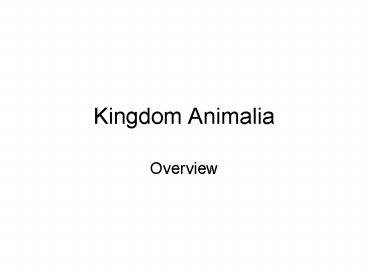Kingdom Animalia - PowerPoint PPT Presentation
1 / 73
Title:
Kingdom Animalia
Description:
Centipedes. Arachnids. Insects. Phylum Arthropoda. Phylum ... Centipede. Arachnids. Arachnids. Arachnids. Honey Bee. Phylum Arthropoda. Phylum Arthropoda ... – PowerPoint PPT presentation
Number of Views:45
Avg rating:3.0/5.0
Title: Kingdom Animalia
1
Kingdom Animalia
- Overview
2
What is an animal?
- Name an animal
3
(No Transcript)
4
(No Transcript)
5
(No Transcript)
6
(No Transcript)
7
Characteristics of Animals
- Heterotrophic
- Cells are Eukaryotic and lack cell walls
- Multicellular
- Most can move from place to place
- Are Consumers
- Cellular Specialization
- Most have organ systems
- Sexual Reproduction
8
Animal Phylum
- Porifera
- Cnidaria
- Platyhelminthes
- Nematoda
- Annelida
- Mollusca
- Arthropoda
- Echinodermata
- Chordata
9
Phylum Porifera
10
Sponge Cells
11
Sponge Budding
12
Sponges
- Have pores
- Food travels into the sponge through these pores
and is filtered out by special cells - Water then leaves the sponge through an opening
in the top - Sponges have no organs
13
Sponges
- Can reproduce sexually by spawning releasing
sperm into the water so it can fall on eggs - Asexually by budding a piece of sponge breaks
off and grows into a whole new sponge
14
Phylum Cnidaria
15
Cnidarians
- Include jellies, sea anemones, coral, and hydra
16
Phylum Cnidaria
17
Cnidarians
- Have a body structure in which all cells come in
contact with the water - Have a mouth through which food enters and wastes
exits - Mouth leads to a hollow gastric cavity in which
food is digested - Have tentacles with stinging cells that shoot
darts into prey and paralyze them
18
Phylum Cnidaria Compared to Platehelminthes
(flatworm)
19
Hydra Eating
20
Phylum PlattyhelminthesFlatworms
21
PlatyhelminthesFlatworms
- Live in water
- Have flat bodies with muscles
- Has eyespots
- Have a digestive system, excretory system, and a
nervous system - Mouth is near the middle of the body on the
underside
22
PlatyhelminthesFlatworms
- Has 2 nerve cords and can respond to the
environment - Reproduce sexually all worms have both male and
female sex organs - Can regenerate
- Are parasites can cause disease (ex. Tapeworm)
23
Phylum Platyhelminthes
24
Phylum Platyhelminthes
25
Cycle of a Tapeworm
26
Liver Fluke
27
Phylum NematodaRoundworms
28
Roundworm
- Have long rounded bodies
- One end of a roundworm has a mouth
- The other end has a anus
- Has a tube within a tube intestines that
digests food - Males and females are separate animals
29
Phylum AnnelidaSegmented
30
Segmented Worms
- Have segmented bodies
- Earthworms have a mouth and an anus
- The intestine is a tube with a crop for holding
food, and a gizzard for grinding food - Most segments have organs to get rid of wastes
31
Earthworm Digestive System
.
32
Seminal Vesicles
33
Segmented Worms
- Has a closed circulatory system with 5 pairs of
hearts - Nerves run the length of the body
- Each earthworm has both male and female sex
organs
34
Earthworm Anatomy
35
Earthworms Mating
36
MolluscaSoft Bodied Animals
- Have soft bodies
- Organ systems
- Most have a shell, some do not
- Shell is made of calcium carbonate
- Smooth inside and pearls are made of mother of
pearl
37
Mollusca
- Snails
38
Phylum Mollusca
- Oysters
- Clams
39
Phylum Mollusca
- Octopus
40
Phylum Mollusca
- Squid
41
Arthropodsjointed-leg animals
- Crustaceans
- Millipedes
- Centipedes
- Arachnids
- Insects
42
Phylum Arthropoda
43
Phylum Arthropoda
44
Crustaceans
45
Millipede
46
Centipede
47
Arachnids
48
Arachnids
49
Arachnids
50
Honey Bee
51
Phylum Arthropoda
52
Phylum Arthropoda
53
Grasshopper Anatomy
54
Grasshopper Respiratory System
55
Phylum Echinodermata
56
Phylum Chordata
57
Phylum Chordates
58
Amphibians
- Newt Poison Dart Frog
59
Amphibians
- Spend part of their life on land and part in the
water
60
Frog Anatomy
61
Female Frog Anatomy
62
Frog Mouth
63
Frog Heart
64
Frog Liver
65
Frog Gall Bladder
66
Frog Stomach, Pancreas and Intestine
67
Frog Nostrils and Tympanum
68
Frog Development
69
Frog Digestive System
- Mouth has vomerine teeth to hold and pierce
insect and maxillary teeth to cut - Tongue attached in front to catch flies and
then push food back - Pharynx throat to push food to esophagus
- Esophagus tube that pushes food to stomach
70
Frog Digestive System
- Stomach mixes food, and begins protein
digestion - Small intestine where food is chemically broken
down and absorbed - Large intestine where water is reabsorbed and
solid undigested material collected
71
Frog Digestive System
- Liver makes bile which emulsifies fats and
chemically processes food - Gall bladder stores bile
- Pancreas makes enzymes that break down
carbohydrates, fats, and proteins
72
Frog Circulation
- A frog has a 3 chambered heart that pumps blood
around a frogs body inside closed blood vessels - A frog has red blood cells that carry oxygen
73
Phylum Chordates































